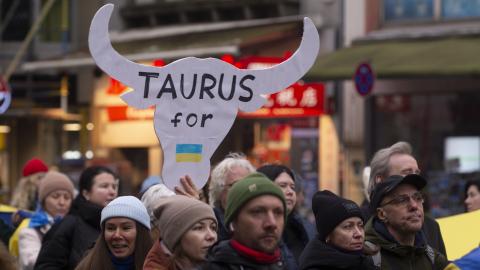Hudson Senior Fellow Can Kasapoğlu offers a military situation report about the war in Ukraine.
Executive Summary
- The Russian military is pressing to capture Ocheretyne, where Ukrainian combat formations are struggling to hold the defensive line.
- Ukraine is receiving new shipments of missiles for the Army Tactical Missile System (ATACMS), but could benefit even more from German Taurus missiles.
- Kyiv is using RAM II drones and military-grade balloons to prey on Russian air defenses.
- The Pentagon is racing to deliver a military assistance package to Ukraine as Kyiv faces mounting troubles on the battlefield.
1. Battlefield Assessment
Last week, Moscow’s widening artillery advantage and Kyiv’s stumbling mobilization efforts allowed Russian forces to make significant battlefield advances and tactical gains on multiple fronts. In the meantime, Russian air and missile strikes continued to pound major Ukrainian population centers.
Russian and Ukrainian forces engaged in heavy clashes and positional fighting in Ukraine’s south and east. Open-source intelligence and satellite imagery show that the most intense combat in the east occurred around Bakhmut, Spirne, Avdiivka, and Chasiv Yar. The latter remains under the most intense pressure. In the south, Russia continued to focus on dismantling Ukrainian positions in the Robotyne bulge, Kyiv’s most significant gain from last year’s counteroffensive, and Krynky, the site of Ukraine’s bridgehead across the Dnipro River.
Available indicators also suggest that Russia has been increasing its troop concentrations in Donetsk Oblast at an alarming rate. Russian engineering units, meanwhile, have been working to connect existing trenches with new fortifications extending to Belgorod Oblast in the east and Zaporizhzhia Oblast in the south.
The Kremlin supplemented its ground offensives with drone and missile strikes against Ukraine’s energy infrastructure. This week the Ukrainian Air Force reported interception rates of approximately 60 percent against these missile salvos. Ukraine’s Ministry of Energy, meanwhile, revealed that Russian strikes significantly damaged facilities in southern and western Ukraine, including in Dnipropetrovsk, Ivano-Frankivsk, and Lviv.
Kyiv also continued to conduct counteroffensive measures against targets inside Russia. The Security Service of Ukraine (SBU) struck two oil refineries and a critical airbase in Krasnodar Krai. Visual evidence from the impact site indicates that these strikes caused significant damage to a warehouse and depot that Russia uses to store UMPK guided bombs. The UMPK, humorously referred to as the “JDAMski” for its similarity to the American Joint Direct Attack Munition (JDAM), is a wing-equipped guidance kit that transforms dumb munitions into guided smart bombs. This innovation transforms legacy weapons, such as the FAB-500 and FAB-1500, into more lethal assets and enables frontal bomber aircraft to release munitions from safer distances.
2. It Is ATACMS Happy Hour for Ukraine, but Kyiv Still Needs the German Taurus Missile
The United States is sending Ukraine a new $1 billion aid package that includes air-defense interceptors, armored vehicles, anti-tank weapons, cluster munitions, and other artillery rounds. This suggests that relief is on the horizon for Kyiv and indicates that Washington may have awakened to the grim possibility of a Russian victory in Ukraine.
Press sources last week noted another important transaction, which went unreported for over a month. In March 2024, the United States allegedly provided Kyiv with additional Army Tactical Missile System (ATACMS) ballistic missiles, including the longer-range variant that is effective up to almost 200 miles. Washington funded this undercover transfer with savings from other arms contracts, disguised it in another $300 million aid package, and delivered the missiles before the US Congress passed its recent $60 billion supplemental assistance bill. Russian sources claimed that Ukraine has already used the ATACMS to strike occupied Crimea.
The design philosophy that informs the ATACMS prioritizes hitting the rear area of an adversary’s critical assets and sharpens deep battle capabilities. The system’s baseline has evolved into several variants in the decades since its combat debut in the Desert Storm campaign of the early 1990s; the most impressive of these is arguably the ATACMS Block 1A unitary warhead configuration, which poses a robust threat against hardened targets. The ATACMS family offers a balanced and much-needed response to the deep-strike weapons that Russia currently employs thanks to transfers from Tehran and Pyongyang.
But Ukraine still lacks the weapon best-suited for use against strategic targets like the Kerch Bridge, which connects the Crimean Peninsula to mainland Russia: the German Taurus missile. The Taurus’s advanced fuse configuration possesses smart-void sensors that allow the weapon to estimate the time required to penetrate different layers of a target after initial impact. This unique feature gives the Taurus an advantage over the Storm Shadow and SCALP-EG missiles Ukraine has acquired from Britain, France, and, recently, Italy. If Berlin wishes to arm Ukraine for victory, it should consider supplying Kyiv with the Taurus missiles it needs.
3. Ukraine Struggles in the Battle for Ocheretyne
In recent days, Russian forces focused overwhelming offensive efforts on Ocheretyne, a small rural town in eastern Ukraine.
Since the early stages of the conflict, Ukraine’s 47th Mechanized Brigade has assumed an essential role in the country’s defensive combat efforts. Kyiv has empowered the brigade to turn the tide in the fiercest battles, including in the prolonged fight for Avdiivka, which eventually ended with a full Ukrainian withdrawal from the city.
The soldiers of the 47th Mechanized Brigade are currently tasked with holding the line in Ocheretyne, alongside individual battalions of other brigades. But these units face growing losses. During a recent rotation that some analysts allege was deeply flawed, Ukrainian troops failed to properly man the front line, leaving a critical gap that Russian combat formations—in particular the 30th Motor Rifle Brigade—swiftly exploited. Open-source intelligence suggests that the 47th Mechanized may be approaching exhaustion, paving the way for what could be one of the quickest Russian victories in months. The 115th Brigade’s efforts to relieve the 47th have not yet succeeded against of the overwhelming Russian push.
4. Ukraine’s Innovative Drones Continue to Trouble Russia
Ukraine’s expanding defense technological and industrial base has been rapidly inventing new solutions. Kyiv’s new long-range, fixed-wing kamikaze drone, the RAM II, follows concepts of operations akin to those of Russia’s Lancet loitering munitions.
The RAM II is part of a broader burden-sharing system fueling the proliferation of Ukraine’s drone program. Under this system, longer-range strategic drones conduct deep strikes on critical Russian military assets like military bases, while swarms of smaller, first-person-view (FPV) drones hunt Russian armored vehicles, main battle tanks, and infantry.
The RAM II has an even more interesting job. The drone operates over air defense zones and preys on Russian surface-to-air missile (SAM) systems, clearing the way for the Ukrainian Air Force to conduct strike missions. The RAM helps minimize risk for Ukrainian pilots while eliminating Russian air defense assets.
Military-grade balloons have also aided Kyiv’s efforts in the skies. Reports from the battlefield suggest that Ukraine, mimicking an earlier Russian tactic, is now bolstering its strike packages with weather balloons that drop mortars. Controlled with commercial electronics and software that calculate wind dynamics for optimal performance and navigation, these assets provide Kyiv with a cheap and effective asymmetrical impact at the tactical level. Ukraine’s armed balloons can fly deep into Russian territory and strike critical targets miles behind the front lines.












